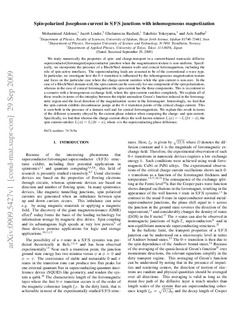| dc.contributor.author | Alidoust, Mohammad | |
| dc.contributor.author | Linder, Jacob | |
| dc.contributor.author | Rashedi, Gholamreza | |
| dc.contributor.author | Yokoyama, Takehito | |
| dc.contributor.author | Sudbø, Asle | |
| dc.date.accessioned | 2017-09-18T08:19:15Z | |
| dc.date.available | 2017-09-18T08:19:15Z | |
| dc.date.created | 2010-01-15T19:15:29Z | |
| dc.date.issued | 2010 | |
| dc.identifier.citation | Physical Review B. Condensed Matter and Materials Physics. 2010, 81 (1), . | nb_NO |
| dc.identifier.issn | 1098-0121 | |
| dc.identifier.uri | http://hdl.handle.net/11250/2455036 | |
| dc.description.abstract | We study numerically the properties of spin transport and charge transport in a current-biased nanoscale diffusive superconductor/ferromagnet/superconductor junction when the magnetization texture is nonuniform. Specifically, we incorporate the presence of a Bloch/Neel domain walls and conical ferromagnetism, including the role of spin-active interfaces. The superconducting leads are assumed to be of the conventional s-wave type. In particular, we investigate how the 0-π transition is influenced by the inhomogeneous magnetization texture and focus on the particular case where the charge current vanishes while the spin current is nonzero. In the case of a Bloch/Neel domain wall, the spin current can be seen only for one component of the spin polarization, whereas in the case of conical ferromagnetism the spin current has the three components. This is in contrast to a scenario with a homogeneous exchange field, where the spin current vanishes completely. We explain all of these results in terms of the interplay between the triplet anomalous Green’s function induced in the ferromagnetic region and the local direction of the magnetization vector in the ferromagnet. Interestingly, we find that the spin current exhibits discontinuous jumps at the 0-π transition points of the critical charge current. This is seen both in the presence of a domain wall and for conical ferromagnetism. We explain this result in terms of the different symmetry obeyed by the current-phase relation when comparing the charge and spin currents. Specifically, we find that whereas the charge current obeys the well-known relation Ic(ϕ)=−Ic(−ϕ), the spin current satisfies Is(ϕ)=Is(−ϕ), where ϕ is the superconducting phase difference. | nb_NO |
| dc.language.iso | eng | nb_NO |
| dc.publisher | American Physical Society | nb_NO |
| dc.title | Spin-polarized Josephson current in superconductor/ferromagnet/superconductor junctions with inhomogeneous magnetization | nb_NO |
| dc.type | Journal article | nb_NO |
| dc.type | Peer reviewed | nb_NO |
| dc.description.version | acceptedVersion | nb_NO |
| dc.source.pagenumber | 9 | nb_NO |
| dc.source.volume | 81 | nb_NO |
| dc.source.journal | Physical Review B. Condensed Matter and Materials Physics | nb_NO |
| dc.source.issue | 1 | nb_NO |
| dc.identifier.doi | 10.1103/PhysRevB.81.014512 | |
| dc.identifier.cristin | 344204 | |
| dc.description.localcode | This is the authors' accepted and refereed manuscript to the article. | nb_NO |
| cristin.unitcode | 194,66,20,0 | |
| cristin.unitname | Institutt for fysikk | |
| cristin.ispublished | true | |
| cristin.fulltext | postprint | |
| cristin.qualitycode | 2 | |
